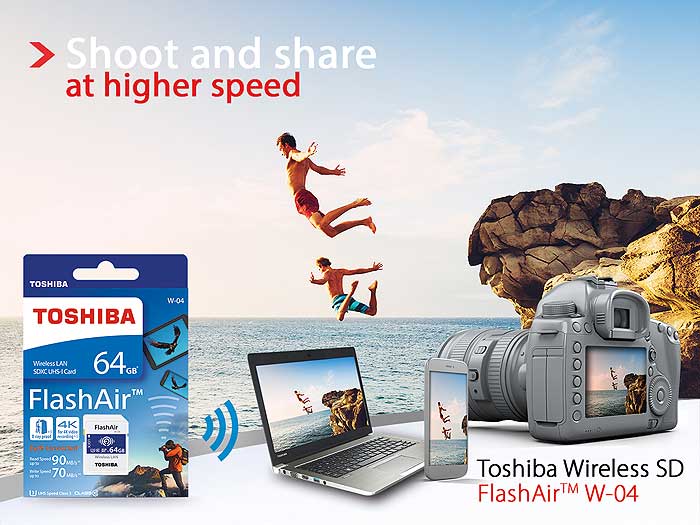 The 4th generation FlashAir features a new processor design and delivers enhanced wireless performance as well as standard SD memory card functionality. It will also offer an integrated ‘Eyefi Connected’ feature[1] that prevents a camera automatically powering off when wirelessly connecting with FlashAir.
The 4th generation FlashAir features a new processor design and delivers enhanced wireless performance as well as standard SD memory card functionality. It will also offer an integrated ‘Eyefi Connected’ feature[1] that prevents a camera automatically powering off when wirelessly connecting with FlashAir.
Toshiba’s new FlashAir cards will start shipping in Q2 CY2017 and be available with capacities of 16GB, 32GB and 64GB[2].
FlashAir products are SD cards with built-in wireless LAN functionality. This allows data stored on the card to be transferred to external devices such as PCs, smartphones and tablets. The 4th generation of FlashAir will be compatible with the UHS-I standard and offer UHS speed class 3 to support 4K video recording[3]. Maximum read and write performance is 90MB/s and 70MB/s respectively[4]. Wireless LAN performance of 31.4Mbps is approximately 2.9 times that of Toshiba’s 3rd generation FlashAir[5].
As well as Toshiba’s own FlashAir application, the latest FlashAir cards work with Ricoh Innovations Corporation’s ‘Keenai’ photo storage and management service. Keenai allows the automatic transfer of photo data from FlashAir cards and enables users to autosync photo and movie data to the cloud[6]. Details of Keenai can be found at: https://www.keenai.com[7].
Notes:
[1] Requires Digital Camera with ”Eyefi Connected” feature
[2] Capacity is based on installed flash memory and not user available memory as part of the memory is used for management functions. Available user area is approximately 14.4GB, 28.8GB and 57.6GB for the 16GB, 32GB and 64GB products respectively (1GB = 1,073,741,824 bytes)
[3] Read/write data transfer rate based on SD standard. 4K video recording operation may vary depending on devices you use and other factors such as file attributes and/or size.
[4] 1 MB/s is calculated as 1,000,000 bytes/s. The maximum transfer speed is the best value obtained under specific conditions in Toshiba’s test environment and Toshiba does not warrant the speed in the equipment to be used. The read/write speed varies depending on the conditions of the equipment to be used. Conventionally, the transfer rate of the SD interface is lower than the UHS-I interface.
[5] In comparison with 3rd Generation FlashAir <W-03> series. Based on typical measured values from Toshiba. The figures shown in this press release are Toshiba’s typical measured values and Toshiba does not warrant those values. The testing environment and conditions were as follows:
Camera:IXY 100F (CANON)
Smartphone:iPhone 7 (Apple)
Measurement method: Time required to download a movie file in a shielded room. Distance between the camera with the 4th generation FlashAir (64GB) / 3rd Generation FlashAir <W-03> (32GB) and the smartphone is 50cm.
Size of the file sent: 49.4MB≒51799654,4byte(video)
Number of files sent: 1
[6] Using Keenai needs a Keenai account. Using autosync function requires paid subscription.
[7] External site opens in a new window.
*FlashAir is a trademark of Toshiba Corporation.
*Keenai is a trademark of Ricoh Innovations Corporation.
*Eyefi is a trademark of Eyefi Inc.
*Apple and iPhone is a trademark of Apple Inc.
Toshiba Electronics Europe
www.toshiba.semicon-storage.com


